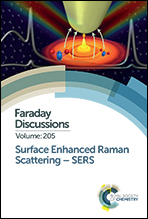Further expanding versatility of surface-enhanced Raman spectroscopy: from non-traditional SERS-active to SERS-inactive substrates and single shell-isolated nanoparticle
Abstract
After surface-enhanced Raman spectroscopy (SERS) was initiated over four decades ago, its practical application seems to be far behind the fundamental research that has made tremendous progress. SERS as a highly sensitive technique has not been widely adopted by the materials science and surface science communities or in the market of analytical instruments. In this discussion, we first classify the previous approaches along this direction over the past four decades and divide them into three strategies. Based on our recent theoretical and experimental approaches, we discuss in more detail the third strategy related to shell-isolated nanostructures. It can significantly expand the SERS study on nontraditional SERS-active (i.e. weakly SERS-active) materials (e.g. Pt, Ni, Fe, etc.) and even SERS-inactive materials (e.g. Si and Al2O3). We then focus on a single shell-isolated nanoparticle and how to controllably locate the strong electromagnetic field just at the probe surface of various materials. The use of side illumination at a high incident angle and/or nanocubes can further enhance the Raman signal by one to two orders of magnitude, which could be helpful for quantitative studies for surface science, heterogeneous catalysis, and soft matter science.
- This article is part of the themed collection: Surface Enhanced Raman Scattering - SERS


 Please wait while we load your content...
Please wait while we load your content...